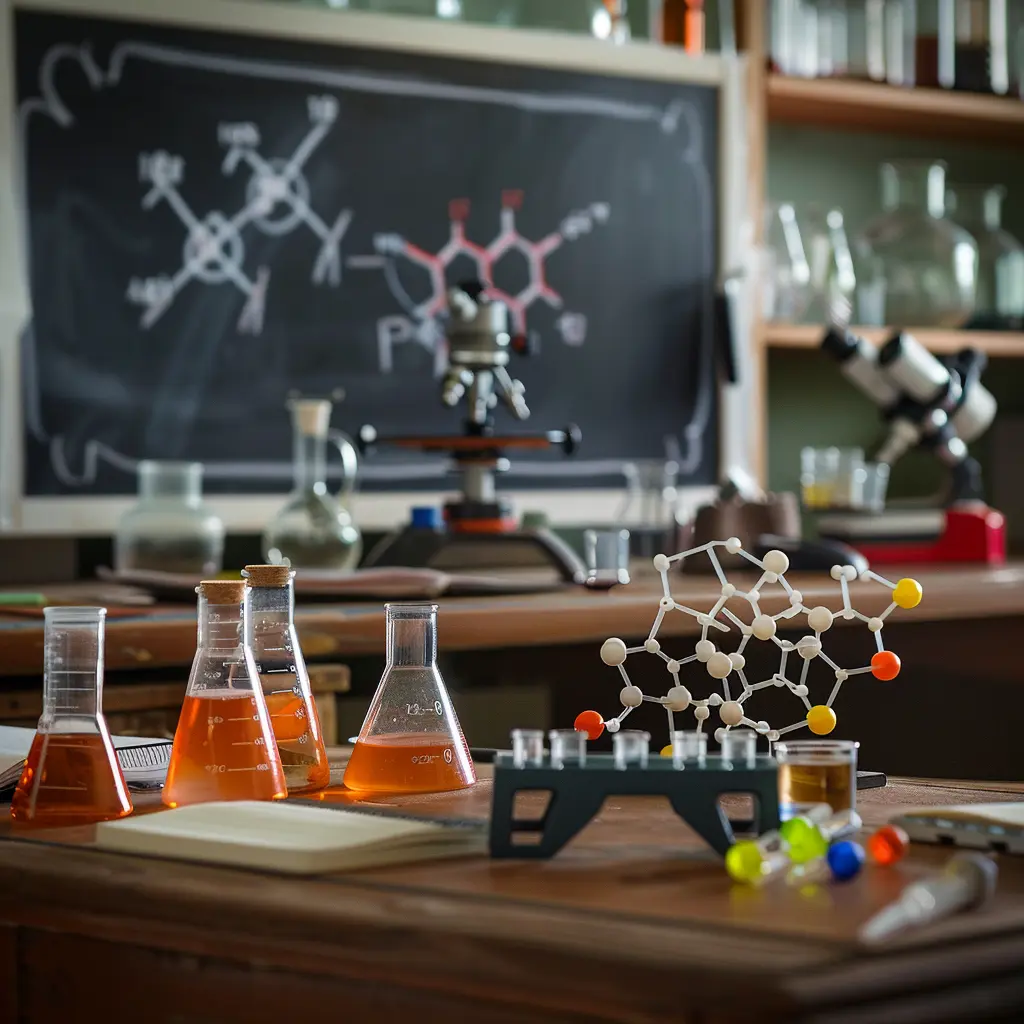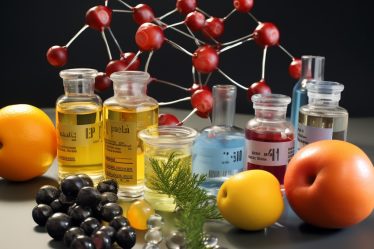
Imagine adding vinegar to a solution but noticing a minimal change in its acidity. This stability occurs due to a buffer—a specialized chemical system that resists changes in pH. Buffers are crucial in preserving the blood’s pH and enabling controlled chemical reactions.
This study guide thoroughly explores buffer solutions. You’ll learn their composition, such as weak acids and conjugate bases, how they neutralize added acids or bases, and their pH range and capacity. Practical examples, equations like the Henderson-Hasselbalch formula, and step-by-step preparation methods will equip you to handle buffers confidently in theoretical and laboratory contexts.
Buffer: Quick Summary
Do you just need the basics? Here’s a simple explanation of what is a buffer:
🟠 Buffers are solutions made of weak acids and their conjugate bases or weak bases and their conjugate acids, maintaining a stable pH even when small amounts of acid or base are added.
🟠 The Henderson-Hasselbalch equation calculates buffer pH using the acid’s dissociation constant (pKa) and the ratio of conjugate base to acid concentrations.
🟠 Buffer capacity measures how much acid or base a buffer can neutralize before significant pH changes occur, depending on the buffer’s concentration and components.
🟠 Examples like bicarbonate buffers in blood and phosphate buffers in labs demonstrate how buffers stabilize pH in biological and experimental systems.
🟠 Buffers stabilize pH through chemical equilibria, where added acids react with the conjugate base, and added bases react with the weak acid.
🟠 Universal buffers, such as mixtures of citric acid and phosphate, combine multiple buffering systems to work across a wider pH range.
What Is a Buffer Solution?
Buffers are solutions that resist changes in pH. Blood is a natural buffer, keeping your body stable even when acids or bases enter the system. This guide explores buffer composition, functionality, and behavior in biological and laboratory settings.
A buffer solution contains a weak acid and its conjugate base or a weak base and its conjugate acid. This pairing allows the solution to resist pH changes when adding small amounts of acid or base. The effectiveness of a buffer depends on its components’ concentration and ratio.
A buffer solution resists changes in pH upon adding small amounts of acid or base, maintaining a relatively constant hydrogen ion concentration.
Key Points about Buffer Solution:
- A buffer stabilizes pH by neutralizing added acids or bases.
- Common examples include blood and laboratory solutions like acetic acid and sodium acetate.
Buffer Examples and pH Ranges
| Buffer System | pKa Value(s) | Effective pH Range |
| Citric Acid | 3.13, 4.76, 6.40 | 2.1 to 7.4 |
| Acetic Acid | 4.8 | 3.8 to 5.8 |
| Phosphate Buffer | 7.2 | 6.2 to 8.2 |
| Borate Buffer | 9.24 | 8.25 to 10.25 |
How Do Buffers Work?
Let’s examine the mechanism using a buffer made of acetic acid ($CH_3COOH$) and sodium acetate ($CH_3COONa$), which dissociates to produce acetate ions ($CH_3COO^-$).
Adding an Acid
When an acid is added, hydrogen ions ($H^+$) react with acetate ions ($CH_3COO^-$):
This reaction neutralizes the excess $H^+$, minimizing the pH change.
Adding a Base
When a base is added, hydroxide ions ($OH^-$) react with acetic acid ($CH_3COOH$) to produce water and acetate ions ($CH_3COO^-$):
This process stabilizes the pH by neutralizing the $OH^-$.
Key Functions of Buffers
- Maintain stable pH in biological systems, such as blood.
- Provide stability in chemical reactions requiring specific pH conditions.
- Assist in calibrating pH meters in laboratory settings.
The Bicarbonate Buffer System
In the human body, the bicarbonate buffer system maintains blood pH between 7.35 and 7.45. This system involves carbonic acid ($H_2CO_3$) and bicarbonate ions ($HCO_3^-$).
Adding Acid
Hydrogen ions ($H^+$) combine with bicarbonate ions ($HCO_3^-$) to form carbonic acid:
$HCO_3^- + H^+ \rightarrow H_2CO_3$
This prevents a significant decrease in pH.
Adding Base
Hydroxide ions ($OH^-$) react with carbonic acid ($H_2CO_3$) to produce water and bicarbonate ions ($HCO_3^-$):
$H_2CO_3 + OH^- \rightarrow HCO_3^- + H_2O$
Reaction Equilibrium in Blood:
This equilibrium ensures blood remains within its optimal pH range.
Components of a Buffer Solution
A buffer contains two critical components:
1. Weak Acid/Base: Minimally dissociates in water, providing stability.
2. Conjugate Base/Acid: Reacts with added acids or bases to maintain pH.
Example: Bicarbonate Buffer in Blood
This buffer helps regulate the pH of blood through the reactions outlined above.
Henderson-Hasselbalch Equation
The Henderson-Hasselbalch equation helps calculate the pH of a buffer:
$pH = pKa + \log\left(\frac{[A^-]}{[HA]}\right)$
Where:
- $pKa$ is the acid dissociation constant.
- $[A^-]$ is the concentration of the conjugate base.
- $[HA]$ is the concentration of the weak acid.
While the equation estimates the pH of a buffer solution, it assumes that the concentrations of the acid and its conjugate base are not significantly altered by dissociation or dilution.
Buffer Capacity and Range
Buffer Capacity: The amount of acid or base a buffer can neutralize before significant pH changes occur.
- Higher Concentrations: Increase buffer capacity.
- Optimal Ratio: A 1:1 acid-to-base ratio provides maximum effectiveness.
Buffer Range: Buffers are most effective within one pH unit of their $pKa$.
Limitations of Buffer Systems
Buffers are most effective within one pH unit above or below their $pKa$; beyond this range, their ability to resist pH changes diminishes.
While buffers are effective at maintaining pH within a specific range, they have limitations. A buffer’s capacity is finite and can be overwhelmed if too much acid or base is added. For example, adding excessive hydrogen ions to a bicarbonate buffer can deplete the bicarbonate ions, causing the pH to drop rapidly. Similarly, buffers are ineffective outside their pH range, typically within one unit of their $pKa$. Environmental factors, such as temperature, can also affect buffer efficiency, as ionization constants change with heat.
In laboratory settings, it’s crucial to monitor buffer exhaustion and ensure conditions stay within their effective range. This helps prevent experimental errors and ensures accurate results.
Preparing a Buffer Solution
1. Select a weak acid or base with a $pKa$ near the desired pH.
2. Mix the acid or base with its conjugate salt.
3. Adjust the pH using small amounts of a strong acid (e.g., $HCl$) or base (e.g., $NaOH$).
Example: Preparing Acetate Buffer
To make 1 L of 0.1 M acetate buffer at pH 4.76:
- Combine 0.1 M acetic acid ($CH_3COOH$) with 0.1 M sodium acetate ($CH_3COONa$).
- Use a pH meter to fine-tune with small additions of $HCl$ or $NaOH$.
Steps to Prepare a Buffer Solution
- Choose a weak acid or base with a $pKa$ close to the desired pH.
- Mix the acid or base with its conjugate salt. For example, use acetic acid ($CH_3COOH$) with sodium acetate ($CH_3COONa$).
- Adjust the pH using a strong acid (e.g., $HCl$) or a strong base (e.g., $NaOH$). Use small increments to fine-tune the pH to the desired level.
Recap: Key Insights About Buffers
- Buffers stabilize pH by neutralizing small amounts of acids or bases.
- Biological systems like blood rely on buffers to maintain function.
- The Henderson-Hasselbalch equation predicts buffer behavior in different conditions.
- Buffer capacity depends on concentration and the ratio of components.
Buffer Variations and Their Effects on pH Stability
Buffers can differ in composition and behavior, affecting how they stabilize pH in specific conditions. Each variation is tailored to meet different chemical or biological requirements.
Single-Component Buffers
These buffers consist of a single weak acid or base and its conjugate counterpart. Acetic acid with sodium acetate is an example, effective within a narrow pH range.
Multi-Component Buffers
Multi-component buffers combine several weak acids and bases, expanding their effective pH range. Universal buffer solutions often contain a mixture of citric acid and phosphate to provide stability across various conditions.
Biological Buffers
Buffers such as the bicarbonate system in blood or phosphate buffers in cells ensure pH stability in living organisms. These systems depend on the balance of carbonic acid, bicarbonate ions, or phosphate species to maintain functionality.
Custom Laboratory Buffers
In labs, custom buffers are prepared for experiments that require precise pH control. The Henderson-Hasselbalch equation helps adjust their components to achieve specific pH values.
Read more about enthalpy in reactions.
Advance Your Knowledge in Buffer with a Tutor
Chemistry sometimes feels overwhelming, especially when working through challenging topics or preparing for exams. If you’re stuck on a concept, finding the right support can make your learning process much smoother and more effective.
A tutor provides personalized attention, helping you focus on areas you require the most improvement. One-on-one tutoring lets you ask questions and move at your own pace, ensuring you fully grasp the material. With tailored lessons, you can confidently approach difficult topics and make steady progress.
Chemistry classes can be a great option if you enjoy learning with others. Group lessons encourage discussion, offer new perspectives, and often include hands-on activities to deepen understanding.
You can find more useful topics in our Chemistry blogs. If you’re looking for extra help, a tutor can guide you through challenging concepts in a way that makes sense.
Search for a tutor using phrases like “chemistry tutor Newcastle” or “chemistry teacher Sheffield” on platforms like meet’n’learn. You’ll find someone who can tailor lessons to your needs.
If you prefer learning in a group, search for “chemistry classes Nottingham” or “chemistry lessons Oxford” online. These searches will lead you to chemistry tutoring options nearby.
Buffer: Frequently Asked Questions
1. What is a buffer solution?
A buffer solution contains a weak acid and its conjugate base or a weak base and its conjugate acid, allowing it to resist pH changes when acids or bases are added.
2. How do buffer solutions stabilize pH?
Buffer solutions neutralize added acids or bases through reactions between the weak acid/base and their conjugates, maintaining a stable pH.
3. What is the Henderson-Hasselbalch equation?
The Henderson-Hasselbalch equation is $pH = pKa + \log{\left(\frac{[A^-]}{[HA]}\right)}$, which helps calculate the pH of a buffer solution.
4. Why is the bicarbonate buffer system important in blood?
The bicarbonate buffer system keeps blood pH between 7.35 and 7.45 through equilibrium reactions involving carbonic acid and bicarbonate ions.
5. What affects a buffer’s capacity?
Buffer capacity depends on the concentration of its components and the ratio between the weak acid and conjugate base or the weak base and conjugate acid.
6. How do you prepare a buffer solution?
To prepare a buffer, mix a weak acid or base with its conjugate salt and adjust the pH with small amounts of a strong acid or base.
7. What is the effective pH range of a buffer?
Buffers work best within one pH unit above or below the $pKa$ of the weak acid or base they contain.
8. Can you give an example of a buffer reaction?
In an acetate buffer, adding acid ($H^+$) forms acetic acid: $CH_3COO^- + H^+ \rightarrow CH_3COOH$. Adding base ($OH^-$) produces water and acetate: $CH_3COOH + OH^- \rightarrow CH_3COO^- + H_2O$.
Sources:
1. LibreTexts Chemistry
2. Britannica
3. Wikipedia



